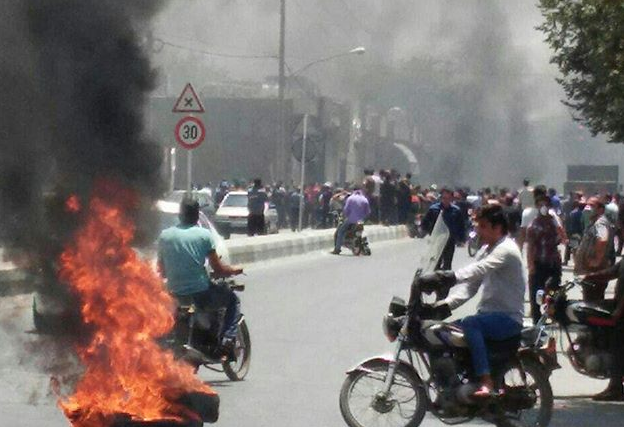Thousands protest for a fourth consecutive day in Iran on eve of US sanctions
Iranians angry with the regime take to the streets fearing further economic woes when American sanctions kick in on Monday

Thousands of people have rallied for a fourth day in Iran against soaring unemployment and a dramatic drop in the currency, as the country braces for the return of crippling US sanctions next week.
Police reportedly fired tear gas and rubber bullets into crowds in a bid to quell the unrest which first unfurled on Monday but have spread across at least 10 towns and cities.
The Iranian Rial has lost nearly two thirds of its value in the last six months alone. Many fear it will only plunge further after renewed American sanctions kick in on Monday, sparking the protests and a run on gold and hard currency.
Footage posted online showed hundreds of furious people gathering in Isfahan, Iran's third city, with some burning tyres to counter tear gas and setting fire to police vehicles. State news agencies also reported "scattered protests” in the southern cities of Shiraz and Ahvaz, to the north in Mashhad and Sari and in Karaj, west of Tehran. Rallies were also recorded in Arak and Shahin-Shahr.
“It was unexpected and seemed to start on social media, there was not much planning. It shows a sudden outburst of anger,” said Saeed Ghasseminejad, an Iran specialist at the Foundation for Defence of Democracies.
He said the unrest posed a major threat to the regime which was struggling to appease the people.
“It is not as widespread as protests in December but has united the lower and middle-income classes. Both small towns and major cities have joined. As the sanctions intensify you will have the upper-middle classes joining too,” he added.
This week’s protests are among the largest to hit Iran since a wave of unrest erupted across more than 80 cities in December and January also over the country’s economic woes. At least 25 people were killed during that time and thousands were arrested.
Protests and strikes re-ignited in June when the Rial took a major hit after President Trump walked out of a 2015 nuclear deal with Iran and ordered his administration to reimpose “maximum“ sanctions by 6 August. Trump administration officials at the time warned they were pushing US allies to cut oil imports from Iran to zero by November.
Iran’s oil sales could drop from 2.4 million barrels per day to as low as 700,000 by the end of the year, according to Facts Global Energy analysis firm.
On Friday Javad Zarif, Iran's foreign minister said China, which heavily relies on Iranian crude, was working to try to restart the nuclear agreement. He said China was "pivotal" to salvaging the pact.
[The Protests] have united the lower and middle-income classes. Both small towns and major cities have joined
But amid the increasing pressure on the economy, last week the Rial hit a record low on the black-market with the Iranian currency trading at a rate of around 120,000 to the dollar.
Ghasseminejad said with fresh sanctions it would likely sink to as low as 200,000 to the dollar meaning further unrest was certain and would likely turn political.
Protesters have already begun chanting against the country’s religious and political leadership as well as against Iran’s costly interventions in conflicts in Yemen, Syria and the Palestinian Territories.
In videos purportedly taken in the town of Gohardasht, a suburb of Karaj, dozens of demonstrators can be seen in the streets chanting “death to the dictator” against Supreme Leader Ayatollah Ali] Khamenei.
In other videos reportedly shot in Tehran, the capital, people were filmed shouting “Get lost you Mullahs”. Some even called for the return of Iran’s king, Shah Mohammad Reza Pahlavi, who was deposed in the Islamic revolution of 1979.
Maryam Rajavi, head of the controversial opposition group the National Council of Resistance, claimed on Friday that police had used tear gas, rubber bullets, and blank cartridges in an attempt to quell "an uprising".
In a statement shared with The Independent the exiled leader said that a number of protesters had also been wounded but gave no further details.
Iran protests – in pictures
Show all 11Amid the protests, residents in Iran reported that people were panicking and stocking up on provisions, dollars and gold in order to ride out the storm, further piling further pressure on the economy.
"People are worried that if they don't buy things today, they won't be available tomorrow," said Ali, a vendor at Tehran’s historic Grand Bazaar, which staged rare strikes two months ago.
Ali added that wholesalers were hoarding new stock while they waited to see how the crisis unfolded.
Holly Dagres, a non-resident fellow at the Atlantic Council, said the crisis and the protests were only going to continue.
"All of the protests are significant as it is showing growing discontent of the Iranian people... and they are only going to keep going on and off as these sanctions pile on. It shows people are fed up with rampant corruption," she said.
"[The government] is trying to put a band aid on the problem but there are also water shortages, power outages, the rial losing its worth, people are disenchanted with the government in general," she added.
Subscribe to Independent Premium to bookmark this article
Want to bookmark your favourite articles and stories to read or reference later? Start your Independent Premium subscription today.

Join our commenting forum
Join thought-provoking conversations, follow other Independent readers and see their replies